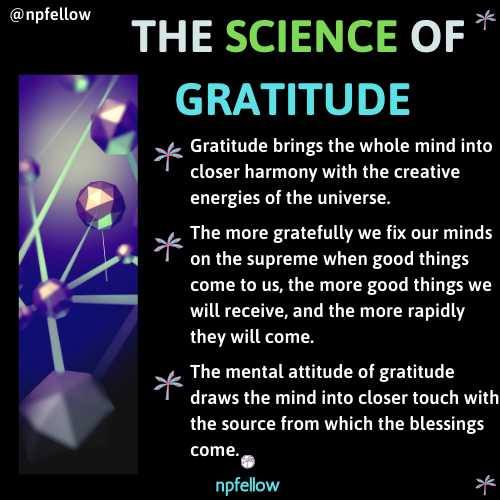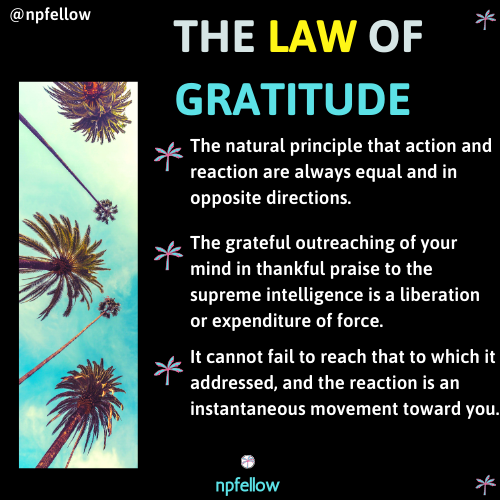Gratitude: The Compelling Force

The practice of gratitude involves focusing on the present moment and appreciating our lives as they are today. By recalling things that make us feel happy and appreciative, it helps us learn to think in terms of abundance, and serves as an antidote to negative emotions like jealousy, envy, regret, hostility, worry and irritation. Focusing on gratitude and positivity helps boost mood and inspires us to get out of our heads and help others get out of theirs. Helping others makes us feel connected, proud, and even more grateful. We can’t always control our circumstances or how things will turn out, but we can try our best to learn from experiences and find something to be grateful for even when things aren’t perfect.
Benefits of Gratitude
Practicing gratitude is beneficial for both our mental and physical health. It shifts our mindset from the competitive mindset to the creative mindset (from competitive thought to creative thought). It protects us from the effects of chronic negative stress, improves heart health, and prevents a long-term low-grade state of inflammation. Being positive and grateful is contagious. Overall, gratitude makes us feel happier, more energetic, more hopeful, and helps us experience more positive emotions. Benefits of gratitude include increased happiness and lowered distress, increased life span, decreased anxiety and depression, contributes to greater meaning in life, boosts connection to others, reinforces healthy habits, and reduces cardiovascular disease.
Gratitude Practices
Practicing gratitude regularly boosts mood and positivity. Performing gratitude exercises allows us to experience multiple benefits and feel happier emotions.
Keeping a gratitude journal allows us to be in the present moment and appreciate life as it is. Writing down things that we are grateful for each morning or each night causes us to think in terms of abundance and cherish what we already have. Meditating or taking time daily to picture 5-10 things we are thankful for allows us to feel gratitude throughout our mind and body. By doing this everyday we can rewire our brain to naturally be more grateful and feel happier after every time. Sending a letter to someone that we are thankful for every so often does not only make their day brighter, but also increases our happiness.
Some people spend most of their time at work, so engaging in formal gratitude practices in the workplace is very important. It doesn’t take much effort at all and a simple thank you can go a long way in the workplace, reducing stress and creating a better work environment. Volunteering in your local community is key to having more gratitude and creating more happiness. It helps others while increasing our own well-being. Lastly, improving our overall happiness can increase our gratitude as well. Participating in hobbies we enjoy like exercise, hiking, art, puzzles, planting, kayaking, etc boosts mood and happiness, and helps us feel more grateful for what we have.

The Science of Gratitude
There is an exact science to gratitude. The whole process of mental adjustment can be summed up by one word, gratitude.
First- you believe that there is one intelligent substance, which all things proceed.
Second- you believe that this substance gives you everything you desire.
Third- you relate yourself to it by a feeling of deep and profound gratitude.
Gratitude will lead your mind out along the ways by which things come, and it will keep you in close harmony with creative thought and prevent you from falling into competitive thought. Gratitude alone can keep you looking toward the all, and prevent you from falling into the error of thinking of the supply as limited – and to do that would be fatal to your hopes.

The Law of Gratitude
There is a law of gratitude, and it is absolutely necessary that we know and understand it, so that we are able to get the things that we seek. If your gratitude is strong and constant, the reaction in formless substance will be strong and continuous; the movement of the things you want will always be toward you. To fix your attention on the best is to surround yourself with the best, and to become the best. The grateful mind continually expects good things, and expectation becomes faith.

The Art of Gratitude
See the things you want as if they were actually around you all the time. See yourself as owning them. Make use of them in imagination just as you will use them when they are your tangible possessions. Dwell upon your mental picture until it is clear and distinct, and then take the mental attitude of ownership toward it, in mind, in the full faith that it is actually yours. Hold to this mental ownership. Be as grateful for it all the time as you expect to be when it has taken form. The person who can sincerely thank God for the things that as yet he owns only in imagination has real faith. He will get rich. He will cause the creation of whatever he wants. Intelligently formulate your desire for the things, which make for a larger life and get these desires arranged into a coherent whole, and then to impress the whole desire upon the formless substance, which has the power and the will to bring you what you want.
Final Thoughts
The practice of gratitude involves focusing on the present moment and appreciating your life as it is today. Focusing on gratitude and positivity helps boost mood and inspires us to get out of our heads and help others get out of theirs. Helping others makes us feel connected, proud, and more grateful. We can’t always control our circumstances or how things will turn out, but we can try our best to learn from experiences and find something to be grateful for even when things aren’t perfect.
Practicing gratitude is beneficial for both our mental and physical health. It shifts our mindset from the competitive mindset to the creative mindset (from competitive thought to creative thought). It protects us from the effects of chronic negative stress, improves heart health, and prevents a long-term low-grade state of inflammation.
It takes 8 weeks of gratitude practices for us to start showing changed brain patterns that lead to greater empathy and happiness.
